Research Article Open Access
Kinetics of Organic Matter Degradation in an Upflow Anaerobic Filter Using Slaughterhouse Wastewater
| Edith Padilla-Gasca and Alberto López López* | |
| Unidad de Tecnología Ambiental, Centro de Investigación y Asistencia en Tecnología y Diseño del Estado de Jalisco, Guadalajara, México | |
| Corresponding Author : | Alberto López López Unidad de Tecnología Ambiental Centro de Investigación y Asistencia en Tecnología y Diseño del Estado de Jalisco Guadalajara, México E-mail: alopez103@yahoo.com, allopez@ciatej.net.mx |
| Received August 14, 2010; Accepted October 15, 2010; Published October 20, 2010 | |
| Citation: Padilla-Gasca E, López AL (2010) Kinetics of Organic Matter Degradation in an Upflow Anaerobic Filter Using Slaughterhouse Wastewater. J Bioremed Biodegrad 1:106. doi:10.4172/2155-6199.1000106 | |
| Copyright: © 2010 Padilla-Gasca E, et al. This is an open-access article distributed under the terms of the Creative Commons Attribution License, which permits unrestricted use, distribution, and reproduction in any medium, provided the original author and source are credited. | |
Related article at Pubmed Pubmed  Scholar Google Scholar Google |
|
Visit for more related articles at Journal of Bioremediation & Biodegradation
Abstract
An assessment of a lab-scale Upflow Anaerobic Filter (UAF) reactor used to treat slaughterhouse wastewater was
carried out with varying operating conditions for Hydraulic Retention Time (HRT) and temperature. The best organic
matter removal efficiency, measured as Chemical Oxygen Demand (COD), was 86.1% at HRT of 24h at 35ºC. Under
steady state conditions, the first-order, Stover-Kincannon and Grau-second-order kinetic models were used to represent
the kinetics of organic matter removal in the UAF. The experimental data showed that the Stover-Kincannon and Grau
kinetic models were the most suitable for predicting organic matter degradation. The kinetic analysis was used to
establish two exponential relationships for determining the kinetic constants for both the Stover-Kincannon and Grau
models as a function of temperature within the mesophilic interval studied. The results from this research study enable
the determination of organic matter velocities, times and efficiencies of degradation which can be used in the design of
an UAF for slaughterhouse wastewater.
| Keywords |
| Slaughterhouse wastewater; Upflow anaerobic filter; Stover-kincannon; Grau-second Order; Degradation kinetic |
| Introduction |
| Municipal slaughterhouses and meat processing facilities generate a large volume of wastewaters which contain a significant amount of organic matter measured as Chemical Oxygen Demand (COD), from 5,000 to 20,000 mg l-1, in addition to having high concentrations of nutrient (nitrogen and phosphorus) and pathogen microorganisms [1,2]. Because of the characteristics of these types of effluents, several authors recommend the application of anaerobic processes, due to the fact that these processes do not require any, or only a minimal, amount of energy. Additionally, they produce a minimal quantity of sludge with the advantage that the biogas produced can be used as a source of energy [3-5]. |
| In spite of the fact that low sludge production is considered an advantage of the anaerobic digestion process, the low velocity of anaerobic microorganism reproduction implies longer Solid Retention Times (SRT) in order to meet high organic matter removal efficiencies in this type of process [6]. |
| The Upflow Anaerobic Filter (UAF) presents advantages over other anaerobic treatment systems such as the Upflow Anaerobic Sludge Blanket Reactor (UASB) or the expanded bed reactor. The UAF maintains the biomass immobilized over a fixed support, which allows the maintenance of high Cellular Retention Times (CRT) in spite of operating at low Hydraulic Retention Times (HRT). Also, the UAF tolerates small variable Organic Loading Rate (OLR) and pH. These features enable a reduction in the reactor’s dimensions and, as a consequence, capital investment, but above all, make it easier to operate [7]. |
| The study of kinetics of anaerobic processes contributes to the understanding of organic matter degradation velocity, which is catalyzed by anaerobic microorganisms. This enables the identification of operational factors (substrate, temperature, pH, among others) that affect kinetics, thereby contributing to the establishment of optimal operational conditions for the treatment process [8,9]. |
| Several authors have developed a number of kinetic models that represent the microbial growth and substrate consumption process in biological treatment processes [10,11]. Their application is based on the microorganism’s capacity to eliminate, by means of assimilation and decomposition, organic matter present in wastewaters [12]. |
| Kinetic models facilitate the assessment of organic matter degradation velocity and the determination of kinetic parameters used for the design, operation and optimization of anaerobic reactors for wastewater treatment. Currently, simplified kinetic models are used with the aim of reducing the number of variables to monitor, which facilitates the study, design and scale-up of biological reactors [13,7]. |
| The objective of the present research was the assessment of the effect of temperature and HRT over organic matter degradation kinetics during the anaerobic digestion process by making a comparative analysis of three kinetic models that describe organic matter removal velocity in an UAF treating slaughterhouse wastewater. |
| Kinetic models |
| Among the most widely used models in the literature for the development of study of kinetics in anaerobic digestion processes are the first-order model, Stover-Kincannon model and Grau-Second order (Grau) model [14,15]; which will be used in this research study and which are described as follows: |
| First order model: The rate of change in substrate concentration in a complete mixed system, considering first-order degradation kinetic and substrate concentration (S) dependence can be expressed as: |
| Under steady state conditions, the rate of change in substrate concentration (-dS/dt) is negligible, then Equation (1) reduces to: |
 (2) (2) |
| The value of the first-order kinetic constant can be obtained by plotting (S0-S)/θH versus S, according to Equation (2). The value of k1 is obtained from the slope of the straight line. |
| Stover-Kincannon model: In this model, the consumption of substrate is expressed as a function of the OLR, due to the monomolecular kinetics of biofilm reactors, such as rotating biological reactors (biodiscs), trickling filters and UAFs. Because of the difficulties in measuring the active surface area, which supports the biofilm, the reactor’s effective volume is used for the Stover- Kincannon model [16]. This model is defined as: |
 (3) (3) |
| here the substrate consumption rate dS/dt is expressed as: |
| Equation (5) is obtained from the arrangement and linearizing of Equation (3). |
 (5) (5) |
| Grau-second-order model: The general equation from the Grau kinetic model is shown in Equation (6) [17]: |
 (6) (6) |
| If Equation (6) is integrated and then linearized, Equation (7) will be obtained: |
 (7) (7) |
| considering that the second term in the right side of Equation (7) is a constant, Equation (8) is obtained: |
 (8) (8) |
| knowing that organic matter removal efficiency is equal to (S0-S)/S0 and is expressed as E, Equation (8) can be re-written as shown in Equation (9): |
| Materials and Methods |
| Slaughterhouse wastewater sampling |
| The wastewater used for this research was obtained from a municipal slaughterhouse. Simple slaughterhouse wastewater samples were obtained during a normal workday to form compound samples. Compound samples were formed by duplicated for each of the sampling campaigns that were carried out in this investigation and were taken to the laboratory and preserved under refrigeration at 4ºC for their further analysis and use during the experimental part of the study. table 1 presents value mean and standard deviation from the analysis of four compound samples. |
| Experimental system |
| An UAF with an operating capacity of 4.6 l was utilized, using plastic packaging with a rounded shape and cylindrical cavities as biofilm support, supplied by ARMFIELD: Engineering Teaching and Research Equipment. This packaging was chosen due to its high void volume, namely 95%, and its large surface area of 3,600 m2m-3. The UAF was fed through a peristaltic pump to control the HRT and a heating system allowed the maintenance of a constant temperature inside the reactor. The experimental determination of methane produced was carried out by using the Mariotte method [18]. This method consists of allowing the biogas produced to pass through a 3M NaOH solution in order to capture and convert the CO2 fraction present in the biogas into Na2CO3, and then, to measure volumetrically the fraction of methane produced. The experimental system used in the present study is shown in Figure 1. |
| Inoculation and reactor stabilization |
| The UAF was inoculated with 870 ml (20% of the UAF’s operating volume) of anaerobic sludge, obtained from an operating and stabilized vinasse treatment plant, with a volatile suspended solids (VSS) concentration of 5,900 mg l-1. The UAF was fed under a continuous regime with a HRT of 36 h. The concentration of COD in the wastewater was increased gradually from an initial value of 1,000 mg l-1 up until the slaughterhouse’s effluent concentration was reached in a period of four weeks. Nevertheless a considerable growth of the biofilm was observed upon the support as well as constant COD remotion after the second week of adaptation and growth of the inoculum. At the same time a constant methane production was observed, which was proportional to the amount of organic matter removed. These evidences allowed to determined that at the end of the fourth week, the UAF was stabilized [3,19]. |
| Assessment of the reactor |
| Operating conditions were established once the UAF reactor was stabilized, which allowed us to assess the reactor’s efficiency as a function of the HRT and temperature, as well as to obtain the kinetic parameters associated with the models used. For the assessment, an experimental design was proposed having two classification criteria, HRT and temperature, with four and three levels, respectively. The proposed levels for HRT were 24, 32, 40 and 48h corresponding to an OLR of 3.1, 3.8, 4.5 and 6.2 kg m-3d-1; while temperature levels were: 20, 27.5 and 35ºC. UAF reactor monitoring was carried out by measuring COD, pH, CH4 and alkalinity parameters every 2 days. |
| Every experiment consisted of keeping temperature and HRT constant during a time period of two weeks. This assured constant removal efficiencies of COD as well as steady state conditions in the system. Once the experiment period ended, temperature and HRT were modified, with monitoring continued. |
| The immobilized biomass on the support was determined as VSS and was quantified in duplicate at the end of the experiments. This was done by separation of the biofilm from the plastic packaging of a determined volume, through successive washing with deionized water in a ultrasonic bath, BRANSON®, Mod. 5510. The VSS gravimetric quantification was made according to APHA’s standardized methods [20]. |
| Kinetic parameters determination |
| The determination of kinetic parameters was carried out using kinetic models in their linear form; Equations (2), (5), and (9). The highest value of the linear correlation coefficient (r2) from the experimental data from each one of the assessed models allowed us to identify the most suitable kinetic model, as well as the kinetic parameters associated with that model and to compare these to the parameters obtained by other authors. |
| Results and Discussion |
| A summary of the results obtained during the operation of the UAF under different HRT and temperatures is shown in Table 2. The values of the following parameters: temperature, COD, OLR, pH, alkalinity are the average of five samples. From this Table, the following overall observations are made: |
| 1. Organic matter degradation efficiencies increased as the operating temperature augmented. |
| 2. For a given temperature, the COD removal efficiency increased as the HRT augmented, except for the experiments at 35ºC, where there was no observable effect of the HRT on COD removal efficiency. |
| 3. The highest organic matter removal efficiency, measured as COD, was achieved at 35ºC and HRT of 24 h (OLR=6.23 kg m-3d-1), which demonstrated that the process was mainly influenced by the temperature rather than the HRT. |
| 4. During the entire experimentation stage, the pH values of the effluent oscillated within a range of 7.2-7.5. |
| 5. Alkalinity, measured as CaCO3 in the effluent, increased from 1,718 to 2,035 mg l-1 as the temperature and HRT augmented. This can be directly related to the process efficiency. These values lay within the suitable intervals for the development of the anaerobic digestion process [21,3]. |
| From the results shown in Table 2, first-order, Stover-Kincannon and Grau models were used to identify which one best represents organic matter anaerobic degradation in an UAF. |
| First-order model |
| A graphic representation of experimental data was made according to linearized form of first-order model, Equation (2), for experiments carried out at 20, 27.5 and 35ºC. The first-order degradation constant values (k1) were obtained from the slopes of the straight lines and were 0.7, 3.1 and 14.1 d-1, with linear correlation values (r2) of 0.58, 0.82 and 0.61 for the respective temperatures as shown in Figure 2. |
| Stover-Kincannon model |
| Figure 3 is the graphic representation of the Stover-Kincannon model in its linearized form, Equation (3), for the three data series at different temperatures. Least squares linear regresion was used to determine the intersection value 1/Umax and the slope KB/Umax. As a result, the calculated values for the maximum substrate removal rate (Umax) were 5.22, 17.12 and 99.01 mgl-1 d -1, and 5.09, 19.75 and 120.88 g l-1d-1 for the saturation constant (KB), corresponding to temperatures of 20, 27.5 and 35ºC. Values for coefficients (r²) were 0.92, 0.99 and 0.99 for the three series of experiments carried out at the different temperatures studied. |
| Grau model |
| Figure 4 shows a graph of the product of the HRT per the organic matter removal efficiency reciprocal [(S0 x HRT)/(S0-S)] versus HRT, according to Grau model linearized equation (8). The kinetic coefficient values m and n were obtained from the intersection and slope of the straight line from the graph. |
| The m values were 1.10, 0.35 and 0.06, and n values 1.03, 1.15 and 1.22, corresponding to the temperatures of 20, 27.5 and 35°C. Then, the substrate removal rate constant (ks) was determined by m =So/(ks x X). Biomass concentration in the bioreactor (X) was equal to 6,500 mg l-1 and was obtained as per the method described in Section 2.4. Subsequently, the values of ks obtained were 0.89, 5.31 and 15.72 d-1 for temperatures of 20, 27.5 and 35°C respectively. Coefficients r2 from the Grau model were 0.91, 0.99 and 0.99 for the studied temperatures. |
| Kinetic models assessment |
| The correlation coefficient r2 was chosen as the criterion for choosing the most suitable model to represent organic matter removal kinetics in an UAF. Considering this criterion, the Stover-Kincannon and Grau models were more suitable than the first-order one, having r2 coefficient values of 0.92, 0.99 and 0.99 for Stover-Kincannnon and 0.91, 0.99 and 0.99 for Grau, in both cases at temperatures of 20, 27.5 and 35°C respectively. |
| Table 3 shows the kinetic coefficients obtained in the present research study at the three temperatures used, by means of the Stover-Kincannon model. These coefficients are compared to the ones reported in the literature. Umax and KB values for this study at 35°C are higher than the ones reported by Iik and Sponza [13] at a similar temperature. This difference can be attributed to the fact that organic matter present in slaughterhouse wastewater is more biodegradable (BOD/COD ratio ≥ 0.6, see table 1) with respect to the waters that contain synthetic dyes (BOD/COD ratio <0.5; Isik and Sponza [13]). On the other hand, Umax and KB at 27.5ºC and 35ºC, obtained in this study are similar with the ones reported by Buyukkamaci and Filibeli [22], who used Poultry slaughterhouse. The differences can be attributed to the type of reactor used, and system’s operating temperatures. |
| For the Grau kinetic model, the value of the kinetic parameters ks, m and n obtained in the present study were basically similar to the ones reported in the literature by Buyukkamaci and Filibeli [22]. The differences among the values can be essentially attributed to the type of substrate used and the operating temperatures, as shown in Table 4. |
| In the present study, it was observed that the kinetic parameters in both the Stover-Kincannon and the Grau model are directly related to temperature. Particularly, KB and ks values increased as temperature augmented; consequently, degradation velocity could have been favored by the increase in KB and ks value, which matches the high efficiencies found at 35ºC. |
| With the results obtained in Tables 3 and Table 4 a relationship was established between the kinetic constants KB and ks within the mesophilic interval studied. |
| Figure 5 shows the exponential relationships of KB and ks, as a function of temperature, with coefficient r2 of 98% and 99%, respectively (Equations (10) and Equation (11)). |
| kS=0.023e0.188τ (10) |
| kB=0.069e0.211τ (11) |
| These relationships allow us to determine the value of the kinetic constants at other temperatures within the studied interval, as well as the velocities and organic matter degradation efficiencies in an UAF for slaughterhouse wastewater. |
| Conclusions |
| The performance of an UAF reactor was assessed under different HRT and temperature conditions, using slaughterhouse wastewater. The best organic matter removal efficiency was 86.1% as COD when the UAF operated at 35°C and a HRT of 24 h (OLR equal to 6.2 Kg m-3 d-1). Temperature was the determinant factor for achieving high efficiencies. |
| Under steady state conditions in the UAF reactor, a comparative analysis was made of the three organic matter degradation kinetic models, which allow us to conclude as follows: |
| 1. The Stover-Kincannon and Grau models described better the organic matter degradation present in slaughterhouse wastewaters, using an UAF. |
| 2. The kinetic parameters have an increasing dependence with respect to temperature. |
| 3. Two exponential relationships were established that allow the determination of the value of the kinetic constants (KB and ks) as a function of temperature, as well as the velocity and efficiency of organic matter degradation in the UAF using slaughterhouse wastewater. |
| Acknowledgments |
| We are thankful for the support for this work provided by the state of Hidalgo (HGO FOMIX. Code 72697) and the scholarship funded by CONACYT for the pursuit of postgraduate studies for the first author. The authors are also grateful to visiting investigator Winston Smith of the United States Peace Corps/Mexico for his assistance in revising this paper. |
| Apendix A. Nomenclature |
| k1 = First-order degradation kinetic constant (d-1) |
| KB = Saturation constant (g l-1d-1) |
| ks = Grau model’s substrate removal rate constant (d-1) |
| m = So/(ks x X) (d-1) |
| n = Grau model Constant (dimensionless) |
| Q = Flow rate (l d-1) |
| S0, S = Inflow and Outflow substrate concentration, respectively (COD, mg l-1) |
| Umax = Maximum substrate removal rate (mgl-1d-1) |
| V = Reactor volume (l) |
| X = Biomass concentration in the reactor (VSS, mg l-1) |
| Greek symbols |
| θH (HRT) = Hydraulic Retention Time (d) |
References
|
Tables and Figures at a glance
| Table 1 | Table 2 | Table 3 | Table 4 |
Figures at a glance
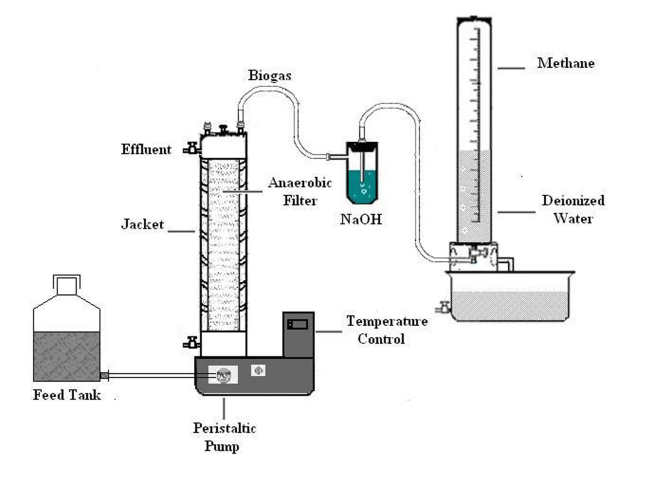 |
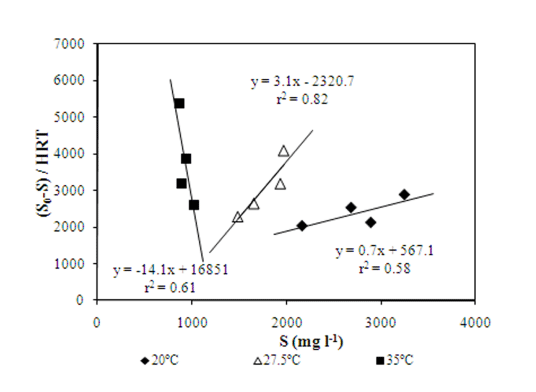 |
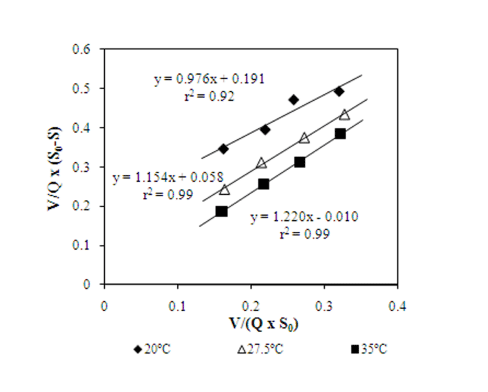 |
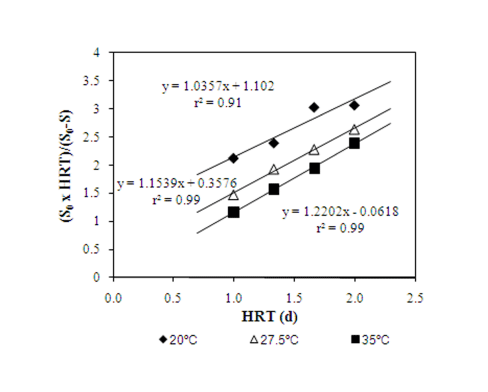 |
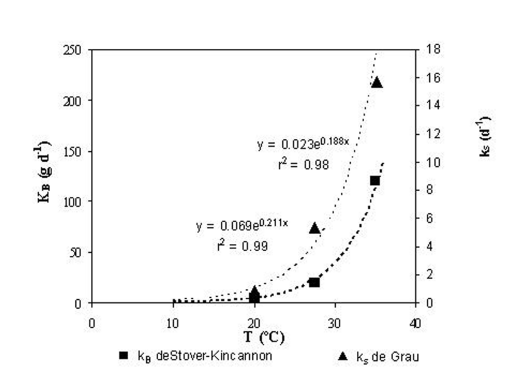 |
| Figure 1 | Figure 2 | Figure 3 | Figure 4 | Figure 5 |
Relevant Topics
- Anaerobic Biodegradation
- Biodegradable Balloons
- Biodegradable Confetti
- Biodegradable Diapers
- Biodegradable Plastics
- Biodegradable Sunscreen
- Biodegradation
- Bioremediation Bacteria
- Bioremediation Oil Spills
- Bioremediation Plants
- Bioremediation Products
- Ex Situ Bioremediation
- Heavy Metal Bioremediation
- In Situ Bioremediation
- Mycoremediation
- Non Biodegradable
- Phytoremediation
- Sewage Water Treatment
- Soil Bioremediation
- Types of Upwelling
- Waste Degredation
- Xenobiotics
Recommended Journals
Article Tools
Article Usage
- Total views: 14896
- [From(publication date):
November-2010 - Dec 20, 2025] - Breakdown by view type
- HTML page views : 10057
- PDF downloads : 4839
